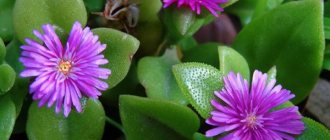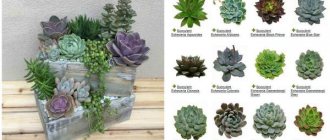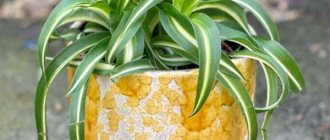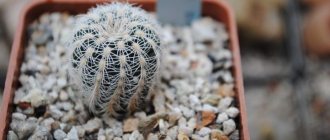Chlorophytum is a herbaceous evergreen plant. It was first described at the end of the 18th century.
A hundred years later the flower appeared in Europe. But botanists have not yet fully decided which family it belongs to - Asparagus, Liliaceae or Agave. Chlorophytum appeared in the tropical forests of Africa and is found in the subtropics of Australia and Asia. Due to its undemanding nature, it is one of the most widespread plants on Earth. Fluffy fountain-shaped bushes of chlorophytum grow up to 50 cm in length and diameter. They grow rapidly, reaching the size of an adult plant within a year. At home they live for about 10 years, then the plant must be rejuvenated. Chlorophytum blooms at any time of the year. Produces white 6-petalled star-shaped flowers. In their place, “babies” grow on long peduncles.
Chlorophytum is simple in everything: care, reproduction, even its name is simple. The word goes back to the Greek roots chloros and phyton and is translated as “green plant.”
| Rapid growth rate, reaches the size of an adult plant within a year. |
| Chlorophytum blooms at any time of the year. |
| The plant is easy to grow |
| Perennial |
Useful properties of chlorophytum
Chlorophytum is an ideal air purifier, the “green lungs” of the home. By drawing in harmful carbon compounds (formaldehyde, chlorethylene, benzene), it generously shares oxygen. The plant releases phytoncides that disinfect indoor air. Reduces the concentration of heavy metals and their compounds; neutralizes nicotine.
Therefore, the chlorophytum flower is indispensable in apartments where smokers, allergy sufferers and people with pulmonary pathologies live. By purifying the air, chlorophytum also moisturizes it and helps absorb extraneous noise. Over the course of a day, 5 average plants neutralize dangerous compounds over an area of 10 m2. In African countries, chlorophytum is used as a laxative for children.
Which pot to choose and how to prepare the soil?
Chlorophytum will grow well in both plastic and ceramic pots. The main thing is that there is a drain hole.
Soil requirements:
- it must conduct moisture efficiently;
- it should be light and conduct air well;
- contain nutrients.
Typically the soil is a mixture of sand, humus and deciduous soil.
Caring for chlorophytum at home (briefly)
Before you decide to plant chlorophytum at home, you need to find out the preferences of the plant and the features of caring for it:
| Temperature | In winter – minimum – + 7°C, optimal – + 9 – 18°C; in summer – up to + 25°C. |
| Air humidity | Moderate; Tolerant of low humidity, but loves showers and spraying; Spray frequently in summer, less often in winter, but do not stop, especially if the flower is located next to a radiator. |
| Lighting | Preferably southwest or southeast location; grows intensively and becomes lush in bright, diffused light; when there is a lack of light, the leaves of the “curly” chlorophytum straighten; green-leaved species tolerate short-term darkening. |
| Watering | The soil should always be moist, but not waterlogged; In winter, water once every 7 days, and in summer - every 3 days. |
| Priming | You can prepare a mixture of 0.5 portions of perlite, turf soil, peat, leaf soil, taken 1 portion each; you can buy ready-made universal soil with neutral acidity; sometimes grown in hydrogel. |
| Feeding and fertilizers | From spring to autumn - once every 14 - 21 days, apply universal mineral fertilizer after watering. |
| Transfer | Every spring - young bushes; after 2.5 years - mature plants (when the roots begin to appear from the drainage hole. |
| Reproduction of chlorophytum | By dividing the bush, daughter rosettes, seeds. |
| Features of cultivation | Young bushes have very delicate, sensitive leaves; they do not need to be wiped to avoid breaking them. Old leaves that have lost turgor are cut off: they interfere with the growth of the flower and spoil its appearance. Chlorophytum loves fresh air, so the room must be ventilated often (the bush is protected from drafts). |
How to rejuvenate a plant
Dividing the bush is also a way to propagate chlorophytum. In addition, it helps to rejuvenate the flower and give it more strength for further growth.
Since chlorophytum is actively growing, it requires replanting every spring. At the same time, the bush can be divided. To do this, it is watered abundantly several hours before the procedure. The soil should be soft enough to allow the plant to be removed without damaging the roots.
The bush is taken out, the roots are freed from the soil and carefully unraveled. Rotten and damaged roots are removed. Then the plant is divided into several parts.
The pot for replanting is selected taking into account the fact that the flower in this container will have enough space until next year. Then the soil is prepared. It consists of equal parts of humus, sand and leaf soil. The soil is disinfected by watering with boiling water. When the substrate has cooled, you can place the bush in it.
Caring for chlorophytum at home. Details
Chlorophytum is easy to grow at home even for a novice gardener. But growing a “green plant” must be approached responsibly, studying its preferences in advance. Then the flower will develop harmoniously and look cheerful.
Chlorophytum bloom
Chlorophytum blooms at any time that does not coincide with the dormant period, most often from April to October. In favorable conditions, the plant blooms for a month, forming small white flowers with elongated ray-shaped petals, similar to stars. The flowers are collected in loose white panicles.
In their place, rosettes of fresh leaves appear, with which you can grow new bushes. If unnecessary rosettes are removed, flowering will continue. Mature chlorophytum surrounded by cascading young rosettes looks like a spectacular green fountain. Owners of Chlorophytum alata remove the spadix-like flower stalks to preserve the brightness of the leaves.
In orange varieties, the peduncle is removed so that the bushes retain their “fluffiness”. A cramped pot and young age may be the reason for the lack of flowering.
Temperature
The chlorophytum flower at home does not require strict temperature conditions, although it is considered optimal to keep the plant at + 9 – 18 °C. In winter, the temperature is reduced slightly so that the chlorophytum can rest well in the coolness. The maximum drop that a flower can tolerate is up to + 7 °C (this is a critical level, it is better not to bring it to this point). In summer, the mercury column can rise to + 25°C.
Drafts and cold air harm the flower.
Spraying
Spraying is a necessary part of plant care.
Although chlorophytum tolerates dry indoor air well, it really likes this procedure, like a warm shower. In summer, spraying is carried out frequently. In winter - less often, but do not stop at all, especially if the plant is located close to radiators. Chlorophytum leaves are sprayed with lukewarm water late in the evening to protect the flower from sunburn. By the dried and yellowed tips of the leaves, you can determine that it is time to spray the flower.
If chlorophytum is grown in a pot and not as an ampelous plant, it can be placed in a tray with wet pebbles (the roots should not touch the water). This will help maintain air humidity.
Lighting
To keep chlorophytum healthy and beautiful, home care advises properly organizing the lighting.
The choice of lighting depends on the type of plant, although generally chlorophytum prefers diffused bright light, but constant exposure to bright light can lead to leaf burns. Shading affects the color quality and appearance of the leaves: “curly” species straighten their leaves, and variegated ones lose their brightness. With slight shading, only green species can be found. Chlorophytum is classified as a shade-tolerant plant, but in low light the color of the leaves quickly fades, the flower becomes sluggish, and its growth slows down.
The bushes feel best in the southeast or southwest part of the room. In summer, chlorophytum is taken out into the fresh air, located away from the scorching sun and rain.
Watering
Watering any plant requires caution and moderation.
If the root system does not have time to absorb the amount of water poured in, it will begin to rot. Chlorophytum has thick and powerful roots. They retain moisture for a long time. It is important to ensure that the soil in the pot is moist, but there should not be excess moisture. Good drainage will help prevent water stagnation. Chlorophytum is watered abundantly on summer days, every three days, in winter - once every 7 days, trying to pour water along the edges of the pot, and not into the center of the bush. You can tell when watering is needed by the appearance of thickenings on the roots, drying and falling of leaves, and drying out of the soil. The flower is watered with settled lukewarm water.
To retain moisture in the soil, mulch with coconut substrate.
Pot for chlorophytum
The bush grows quickly, so the pot has to be changed often, taking into account that the diameter of the new container should be 3 - 5 cm larger. The pot for chlorophytum is chosen to be wide and not very high, so that the roots, spreading in breadth, grow freely.
In a cramped container, the plant may not bloom. But when replanting chlorophytum into a larger container, you must not overdo it with the choice of diameter: in a pot that is too wide, the plant will take a long time to settle in, which means it will have to wait a long time for flowering. In a clay pot, water evaporates quickly, and chlorophytum likes the soil to be moist, so a clay pot is not suitable for a flower. Often green bushes, like hanging plants, are planted in hanging flowerpots. Some gardeners plant the plant in tubs with palm trees.
Sometimes, instead of a traditional pot, chlorophytum is grown in a glass display case or in a florarium made from a spacious aquarium. Surrounded by colorful pebbles, starfish and shells, it looks wonderful.
Soil for chlorophytum
The soil for chlorophytum needs to be loose and light. You can buy a ready-made mixture for flower plants. A substrate for roses, begonias or palm trees that has neutral acidity (pH 6.4 - 7.3) is suitable. If the reaction is acidic or alkaline, the plant will not develop well. You can prepare the substrate yourself by taking 1 portion of turf soil, peat, leaf soil and 0.5 portions of perlite. Be sure to use good drainage - from pieces of brick, large pebbles, expanded clay.
Recently, chlorophytum is often planted not in the ground, but in hydrogel. Bushes planted in florariums in this way look impressive. But, following the fashion, you need to know some of the features of growing flowers in hydrogel. Young plants are best suited for this: they take root more easily in a new environment.
The roots of the bush are washed from the soil before planting. Chlorophytum in hydrogel is not placed in bright light. The hydrogel is washed periodically to avoid stagnation of water. To retain moisture in the hydrogel, water is sometimes added to it.
Feeding and fertilizer
Feeding and fertilizer help chlorophytum keep the leaves elastic and bright; support the flower during the formation of daughter rosettes and promote the growth of “babies”. From spring until autumn, chlorophytum is fed with liquid universal fertilizer, diluted by half, every 14–21 days.
Mature specimens are fed in the spring, once a year. Some gardeners sometimes feed the plant with a three-day infusion of banana peel, which is a natural source of trace elements and vitamins. Fertilizers are applied to moist soil in the evenings or in cloudy weather. In winter, chlorophytum is not fertilized.
After replanting the flower, 1-5 weeks should pass, only then do they begin to feed it.
Chlorophytum transplant
Replanting chlorophytum is necessary if the roots of the plant begin to appear from the drainage holes of the pot.
Usually young bushes are replanted annually - in the spring, and sometimes you have to do this several times a year - young chlorophytum grows so quickly. Mature plants need replanting less often - after about 2.5 years. Adult bushes are sometimes simply refreshed with the top layer of soil, without replanting. When removing a flower from a pot, inspect its roots. Dry or rotten fragments are removed. The cut areas are sprinkled with crushed coal and dried a little. Plant in a new pot so that there is 3.5 cm left to the walls and bottom so that the roots are free and can develop.
Drainage must be poured into the bottom of the container.
Trimming
The leaves of the plant are formed in the center of the root rosette. To form the crown of the bush, chlorophytum is not pruned. In this case, pruning is carried out for cosmetic purposes to give the flower a neat appearance. Using this procedure, dried or broken leaves are removed. Sometimes daughter rosettes are cut off, feeding on the juices of the mother bush and weakening its growth.
Rest period
Chlorophytum is ready to purify indoor air all year round; its dormant period is clearly not expressed . The task of a caring owner is to send the flower to rest so that it can lay new flower buds. In winter, chlorophytum is moved to a cool room, they stop feeding and rarely water.
Is it possible to leave chlorophytum without care during the holidays?
If you go on vacation for 2 weeks, you can rest assured: chlorophytum will withstand the lack of watering. Just before leaving, you need to water the flower and move it to a shaded place. During this time, the leaves may droop, but no insoluble problems will arise.
If you are planning a longer absence, it is better to ask your loved ones to look after the “green plant”, leaving water and a watering schedule. Be sure to place an open container of water next to the flower to maintain air humidity.
Homemade chlorophytum is not demanding in terms of maintenance conditions; if even basic conditions are created, it will delight you with its excellent appearance.
Optimal conditions and timing of reproduction
Reproduction should be planned for early spring. However, if required, it can be carried out in the summer. After planting, the flower should be placed in a place with diffused light.
During the first 1.5 weeks of adaptation, this location will be the best for active growth and development. In the future, the plant will be able to grow well both in a sunny place and in the shade. The only thing is that on the sunny side the colors of its leaves will be brighter.
The temperature of the flower does not matter. It can tolerate a decrease in the thermometer to +8°C and an increase to +32°C without harm to decorativeness. The flower also does not make any demands on air humidity. Does not require spraying.
Reproduction of chlorophytum
Depending on the type of plant, propagation of chlorophytum is possible in different ways.
Growing chlorophytum from seeds
Acceptable for species that do not form “children,” for example, for Chlorophytum orange.
- Fresh seeds are wrapped in a moistened napkin and placed in a plastic container.
- Cover with a lid and germinate at + 25 - 28°C, periodically wetting the napkin.
- After 2 weeks, when the seeds “hatch”, they are planted in moist soil to a depth of 5 mm, trying not to damage the long white sprout.
- Cover with film and leave in a warm place.
- The film is removed to water and ventilate the plant.
- When true leaves (2–3) form, the seedlings dive.
Reproduction of chlorophytum by rosettes
A simple method in which rosettes that have grown to 5–8 cm are separated from the peduncles. By this time, many rosettes already have roots, but if they are not there, the bush is rooted in loose soil or in water (the water must be changed more often). When rooting in water, wait for roots to appear. Then they are planted in the soil. Young “babies” take root quickly. Crested and curly species are easily propagated by this method. But the method is not suitable for winged and cape chlorophytum: they do not have “whiskers”.
Reproduction of chlorophytum by dividing the bush
Such propagation is timed to coincide with plant transplantation.
- When a plant is removed from a pot, the rhizome is washed.
- Using a sharp knife, divide it into fragments and sprinkle the cut areas with charcoal powder.
- Damaged roots are removed, elongated roots are shortened by half.
- The prepared parts are planted in the ground. A quick option for getting a powerful bush.
In this way, it is recommended to rejuvenate the bush once every 5 years. This method is suitable for propagation of all species.
The most favorable time for the propagation of chlorophytum is spring, when chlorophytum, which has rested over the winter, is ready to give birth to a new plant.
How to plant a chlorophytum baby correctly
Chlorophytum crested is usually propagated by children. Its rosettes already have roots and are immediately ready for transplanting. But there are varieties in which the children grow only with leaves. They must be separated in advance and placed in a glass of water until the rhizomes appear. You can prepare cuttings in a similar way. They also take root well.
For planting you will need special soil. To prepare it, take turf, leaf soil and sand in a ratio of 3:1:1. A little peat and humus is added to the resulting mixture. A drainage layer of small pebbles must be placed at the bottom of the pot so that the roots do not rot from excess moisture.
Young children are suitable for such reproduction. The old ones take root much worse. You need to take rosettes from plants that are 3-4 years old in spring or summer.
Diseases and pests
Usually, with proper care, chlorophytum grows healthy and beautiful - a real “green plant”, but sometimes it is attacked by diseases and pests. The flower will announce the problem by changing its appearance:
- the leaves of chlorophytum turn yellow - rot of the roots from the fungus (if the root is completely blackened, the plant cannot be saved; if minor areas are affected, they are removed, the cut areas are sprinkled with coal powder, transplanted into new soil and not watered for several days, kept in the shade);
- brown tips of chlorophytum leaves - lack of nutrients or high temperature in the room (feed, move to a cool place, ventilate);
- brown stripes on the leaves of chlorophytum in winter - excess moisture (you can dry the roots, replant the flower in new soil, do not water for several days; adjust watering);
- curled leaves with yellow-brown spots, brown edges of chlorophytum leaves - severe moisture deficiency (water abundantly, adjust watering);
- chlorophytum grows slowly - lack of nutrients, little light (feed, move to a brighter place, turn on the phytolamp);
- Chlorophytum does not produce babies - the pot is cramped or the flower is immature (transplant into a more spacious pot);
- Chlorophytum leaves turn pale - little light or lack of nitrogen (move to a brighter place, feed);
- rots in the center - excess moisture (dry the roots of the flower, replant in new soil, do not water for several days, then adjust the watering);
- the leaves have become soft - the plant is cold (move to a warm place);
- light brown dry spots on the leaves – sunburn (shade);
- dry tips of leaves - dry air in the room (spray, place on a tray with moistened expanded clay);
- chlorophytum begins to fall on its side - the bush has grown too large (divide into fragments and replant);
- leaves turn black in summer - little moisture, dry air (water generously, spray, place on a tray with wet expanded clay).
Sometimes chlorophytum is affected by insects: thrips, aphids, mealybugs, nematodes. Insecticides are used against them. If there are few pests, you should first try traditional methods.
Features of care
The plant is extremely unpretentious. But in order for it to feel good and grow actively, you should follow simple rules.
Lighting
Partial shade is preferred. The optimal place to place the flower is the east or west side. If the windows face south, it is better to remove the pot from the windowsill so that the leaves do not burn in direct sunlight.
Humidity
This tropical plant loves high humidity of 40-90%, but also thrives in dry climates, although it grows more slowly. It is useful to regularly spray the bush with a spray bottle and wipe the leaves with a damp cloth to remove dust.
Temperature
Chlorophytum tolerates both heat and coolness well. It is advisable that the temperature in the room with the flower does not fall below + 10 C.
Watering
For these purposes, use settled water at room temperature. Water should be abundant so that the liquid saturates the entire soil and flows into the pan. The next watering is done when the surface of the soil dries out but remains slightly moist. It is important not to overwater the plant, otherwise the roots will rot and the leaves will become heavy and break.
It is better not to add chlorophytum than to overfill it. You should carefully monitor the well-being of the plant and maintain the humidity balance.
Top dressing
In the first 3-4 months after planting, fertilizing is not required. Then every couple of months you should fertilize the plant with a complex solution for indoor flowers.
Trimming
The bush needs sanitary pruning as needed. Damaged parts of the leaves are removed with sharp scissors or pruners. If the leaf is severely broken off or dried out, it is torn off close to the stem.
Pruning is done before the next watering, when the foliage is not too juicy. Peduncles are cut off at the base or internode after the babies are removed.
Chlorophytum used to be found in every apartment. Now he has become undeservedly forgotten. And completely in vain. This plant can decorate any interior; it looks simple and chic at the same time.
You can learn more about how to propagate chlorophytum and how to transplant it by watching the video:
Types of homemade chlorophytum with photos and names
A little more than 200 species of chlorophytum are found in natural conditions. Only a few of them are cultivated at home.
Chlorophytum comosum
The most common type of chlorophytum. Elongated narrow (about 2 cm) leaves hang freely. They have a lanceolate shape and a bright green color. The arrow grows up to 100 cm, first small pale flowers (up to 7 pieces) form on it, then “baby”.
Some of its varieties are the most popular.
Variety (Chlorophytum Vittatum)
A narrow white stripe runs along the leaf blade.
Variety (Chlorophytum Variegatum)
Light stripes run along the edges of the leaf plate.
Chlorophytum comosum Bonnie
A compact bush with short, spiral-shaped leaves that give the plant a playful appearance. The center of the leaf blade is clearly marked by a cream stripe.
Orange chlorophytum, or star orchid (Chlorophytum orchidastrum)
A species radically different from other types of chlorophytum. The height of the bush is up to 40 cm. Wide powerful leaves on long orange petioles are alternately formed from the basal rosette. They have a dark green color. The short peduncle is shaped like an ear. “Children” rarely form.
At home, 2 varieties are often grown:
Variety (Green Orange)
A wide dark green leaf blade is supported by a bright orange petiole. The vertical stripe on the leaf has the same color.
Variety (Fire Flash)
It is distinguished from the Green Orange variety by the absence of a bright orange stripe; only a thin reflection of the bright petiole is visible.
Chlorophytum capense
Wide (3 cm) elongated (almost 60 cm) bright green leaves. They have a grooved shape. Small snow-white flowers are formed on short peduncles. The main difference from Chlorophytum crested is that as a result of flowering there are no “babies”.
Chlorophytum is an ideal plant for the home, found in almost every apartment. Lush greenery evokes positive emotions and purifies the air. Planted in hanging containers or florariums, “green plant” bushes enliven the space and emphasize its uniqueness.
Currently reading:
- Alocasia domestica. Growing and care
- Coleus - planting and care at home, photos of species and varieties
- Oleander
- Platicerium - home care, photo
- Duranta - home care, photos of species and varieties
Botanical description of the plant Chlorophytum
Chlorophytum, Latin - Chlorophytum, folk - “spider plant”, “splash of champagne”, “family happiness”, “friendly family”.
Herbaceous plant with drooping stems. Its long linear leaves are collected in basal bunches. Chlorophytum flowers are small, collected in a loose panicle. After flowering, the arcuate stems form bunches of leaves with aerial roots at their ends. Strong specimens have numerous hanging stems with rosettes of leaves.
In indoor floriculture, species with green and striped linear leaves are grown. They are collected in a basal rosette and arched to the sides, reaching a length of up to 40-50 cm. Long tendrils-peduncles, decorated with small graceful white flowers, grow from the center of the rosette, which later turn into small rosettes - children with aerial roots. Sometimes flowers are cross-pollinated and then the formation of a fruit - a triangular capsule - is possible. There are about 250 species of this plant.
Benefits of the plant
The benefits of chlorophytum include the beneficial effect it can have on the well-being of household members - the plant can significantly affect the improvement of air quality in the house. The plant absorbs carbon dioxide and formaldehyde, refreshes and humidifies the air - so it is worth placing it in the bedroom. Presumably, it can reduce the negative impact of electromagnetic radiation, so it is recommended for rooms where there is a computer or TV.
Chlorophytum is safe for pets and does not contain toxic substances that could harm them. Often the ends of long grass leaves are chewed by cats - no need to worry, after such fun our pets are in no danger.
We hope that with our guide you will have no problem growing and caring for chlorophytum in your home. This indoor plant is very easy to care for, but looks great, delighting with beautiful green leaves of various colors. And for busy people who do not have time to satisfy the exorbitant demands of flowers, this is an absolutely ideal plant.
Possible problems
Due to improper care, some problems may arise after transplantation.
- The tips of the chlorophytum leaves have become dry and brittle. The reason for this may be a lack of water or an excess of sunlight, as well as low humidity in the room.
- The leaves of the plant began to turn black and rot. This is due to excess moisture in the soil, which is caused by frequent watering of the indoor plant.
- Chlorophytum leaves began to turn yellow. The reason was lack of light. This plant loves well-lit rooms. If there is a lack of minerals, the plant may also begin to wilt. This can happen when a flower is cramped in a pot. To make sure of this, you should lift the leaves and inspect the root system of the plant. Perhaps the time has come to transplant the chlorophytum into a wider container.
- Chlorophytum growth retardation. This may be caused by an incorrectly sized pot, since a large container is also not suitable. The flower will not grow until the roots fill the entire space. Growth may stop if the soil for chlorophytum is too heavy or not sufficiently saturated with minerals and fertilizers.
- If a plant does not produce babies for a long time, it means that it is cramped in this pot or does not have enough sunlight.
- The plant does not grow the mustache that is characteristic of it. This is due to a lack of light, as well as fertilizer and watering. We need to reconsider his care.
- Chlorophytum has lost its former color and has become more faded and dull. The reason is low lighting. Therefore, the plant must be placed on a windowsill or at least near a source of constant light.
- Fragility of flower leaves appears when there is a lack of lighting or when there is an excess of fertilizers in the soil.
- If the flower begins to rot, this is due to inappropriate air temperature (too low), which causes moisture retention in the ground.
- If the leaves of an adult flower begin to curl, it means that it needs to be fed with fertilizers and subsequently transplanted into a freer container.
- The appearance of spots on leaves, as well as root rot, is caused by pathogenic bacteria. You must immediately purchase a plant protection product against fungus.
For information on how to propagate chlorophytum with rosettes, see below.
Chlorophytum quickly adapts to light
Chlorophytum is not afraid of changing places and adapts well to sometimes completely different conditions, especially if you give it time to get used to it and do not make a too abrupt transition. Even if the mother plant is accustomed to bright light, the children separated during propagation can be grown as shade-loving and vice versa.
Chlorophytum is able to grow in bright diffused light and in partial shade of any intensity.
Chlorophytums will not withstand anything other than dense shade and midday direct sun. This plant is capable of growing in bright diffused light and in partial shade of any intensity, in natural and completely artificial light. It’s worth taking a closer look at – it’s easy to find the “boundaries” of what’s acceptable by its color and height.
And a few nuances that you should always remember:
- variegated varieties in shade may lose their color (but their growth rates rarely suffer);
- The brighter the light, the more actively the chlorophytum develops, but it is easier to contain the plant in partial shade.
Methods
Most people whose homes are decorated with this wonderful flower are wondering how to propagate this plant at home. You should know that, if necessary, in addition to propagation, chlorophytum should be periodically replanted for its further normal development and vital activity. This should be done as soon as the root system has grown so much that it begins to occupy the entire volume of the pot. This process will not take much time. For it, you need to purchase a larger container in which the entire transplanted flower with all its contents is placed. It is enough to simply fill in the missing areas with new soil.
It is best to do replanting (as well as propagation) in the fall. The container should be free for the plant and wide, not deep.
It is better to choose ceramic or plastic material, which retains moisture the longest. There are several ways to propagate chlorophytum, which is carried out during the vegetative period of the flower’s life. Among them are propagation by children, cuttings and seeds.
Children
Chlorophytum begins to bloom quite early, already in the second year of life. This can be seen in the appearance of his children's mustaches. In order for the children to begin to grow and develop independently, they need to be placed in the soil of a pot of an adult plant, in no case cutting it off before rooting. Another way to propagate chlorophytum with the help of children is to place them in a container with water until roots appear. After which the seedling can be planted in a separate pot with soil.
Cuttings
This propagation method is the easiest and is the one most often chosen by gardeners. To grow a new chlorophytum in this way, just place a good cutting in a glass of water. And as soon as the cutting begins to take root, it should be planted in the usual way in a free container with soil.
Seeds
In order for the planted chlorophytum seeds to produce their results, this should be done in the autumn season. Dry seed pods are collected from the plant. They are soaked in advance for a day in water or a diluted growth regulator. The seeds are then compacted into a pot consisting of a mixture of sand and fertilizer. The top of the container is covered with a glass lid, plastic bag or cling film. Planted seeds should be kept in a semi-dark place. From time to time, the sprouts should be opened for oxygenation and spraying.
The first seedlings appear after 3-5 months. After their appearance, the lid needs to be opened much more often so that the flower begins to adapt to external conditions. With the appearance of the first small leaves, chlorophytum can be transplanted into a pot for an adult plant. In addition to seeds, chlorophytum can be propagated by rosettes. To do this, dig a poured socket into a container with soil. In this case, the flower quickly adapts to new conditions and begins to grow.
Chlorophytum is safe even for children and animals
Chlorophytum is the first plant that you will come across in recommendations for selecting plants for landscaping a nursery. It is not just safe, but useful from all points of view. Its ability to absorb toxins and harmful substances is record-breaking. The harmonizing effect on the interior, thanks to the light, soft colors and shape of the curtains, shoot lines and leaves, is difficult to overestimate.
Chlorophytum is an island of calm and tranquility that will help soften all the sharp corners and straight lines and alone replace up to 5 other plants.
Indoor plants for children's rooms: (read more)
And an important bonus: you simply cannot find a better view for teaching a child how to care for plants or study plants and their propagation. Fast growth, endurance, and unpretentiousness will help you quickly get a beautiful plant even with imperfect care.











